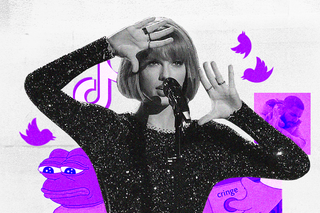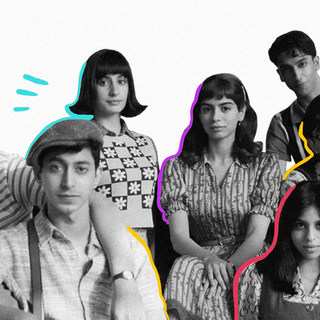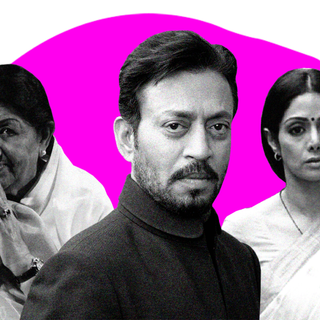
A Cultural History of ‘Cringe,’ and How the Internet Made Everything Awkward
Taylor Swift’s call to embrace cringe leads us back to the wholesome, compassionate origins of cringe rather than the ones found in contempt.

There is a phase in everyone’s lives, a time not so long ago but feels ridged away in memory, which inspires only violent disgust in hindsight. The body instinctively contorts and convulses in shame of violating arbitrary social mores. These felt like violations indeed: a decade-old Facebook post that made liberal use of capitalization and punctuations to litter our language (HapPY BiRthDaY, BeStiE!!!); a text-turned-essay sent to an ex that would instantly be regretted five minutes later; the acid wash jeans that used to be a staple in the wardrobe but now is better left washed away from memory; a video of an actor praying to Audrey Hepburn’s portrait before walking the red carpet at Cannes.
One word, five letters, an inexplicable feeling: cringe. A curled upper lip, a wrinkle on the nose, a weighted sneer, a shake of the head from side to side. To the assault on grammar, excessive displays of human emotions, fashion that was meant to die, any and every behavior that forgets social norms.
Yet, there’s a churn underway in the tale of cringe culture. Taylor Swift in a graduation commencement speech, among other bits of advice on growing up, urged people to “embrace” and learn to “live alongside it [cringe].” Retrospective cringing will always happen, so be wild, be free, and accept the revolting and the hilarious in equal measure.
The story of cringe is the story of a Russian doll, but one that looks a lot like you and me. We cloak that cringe with shame, then with comedy, then with an infraction so severe that shan’t be committed, and now the biggest piece is one of acceptance. Lurking underneath it all is still that cringe, that sense of public shame, but how we grow around it.
Plot cringe on a cultural graph and it would take the shape of a lustrious zig-zag: it started out as a way to show mild embarrassment and shame, inspired a genre of comedy, became a serious social transgression, and now, a way to reclaim the “non-chic” and the “uncool.”
Thehistory of cringe is rooted in social submission. What reached its peak through the internet culture first originated in the Old English; cringan was the word to describe “to fall, to yield in battle, to give way, to become bent, to curl up.” Cringan became cringe sometime in the 16th century when it introduced the feelings of fear and embarrassment to “bending” or “crouching.” Finally, by the 19th century, the meaning had cemented itself; cringe meant to “recoil in embarrassment, shame, or fear.”
Related on The Swaddle:
Why We Find Cringe Couples Fascinating
Evolutionary history shows cringe is birthed by the fear of social rejection — a feeling similar in intensity to physical pain. People literally crinkle in embarrassment also because the ability to “feel vicarious embarrassment is influenced by our ability to empathize with others,” psychology professor Rowland Miller told Vox. People cringe for reasons beyond contempt; it can be compassion too for having experienced a feeling similar to that unfolding in real-time. Cringe was then about second-hand shame and empathy — human emotions that defined anything and everything we do. Cringe, at its heart, is as much an instinct as it is a conditioned physical response, to public shame.
Then came the rise of “cringe comedy” that truly added the humor to the fluster. It is the 2000s, when Larry David of Seinfeld fame went on to create Curb Your Enthusiasm — a saga of awkward misadventures that capitalize on the brand that was cringe. The Office furthered this trend, when to cringe was to both laugh and feel a revulsion from the second-hand embarrassment for people who were unwittingly the butt of the joke. Michael Scott’s mischances with women and his colleagues add the c, r, i, n, g, e in the word cringe.
Watching train wrecks in fictionalized worlds spilled into a desire to mock those in real life. This coincided with a new public space that made humiliation a currency to reach social capital. “With a new form of public space—the virtual—comes the navigation of new social norms and, consequently, new ways to be humiliated. In 2012, Michael Dombkowski started Reddit’s first cringe-specific forum, curating a repository of content that was “hard to watch,” “embarrassing,” or “impossible to sit through.” Sample? A video of a Microsoft Store dance to the Black Eyed Peas song “I Gotta Feeling” for much, much longer than needed. “I always saw these videos as an empathetic exercise. It was always like, Oh, I could totally see myself doing this, or it just felt like one of those nightmares where you’re at school with no pants or something. It just fills you with dread for that person,” he said.
Our instinct to cringe reinforces the new norms of online social behavior on a bodily level,” wrote Caleb Madison for The Atlantic. Social media truly became a prism for cringe to thrive into a rainbow of meanings; it was an adjective (such a cringe dress), a verb (I’m cringing at her song), a noun (stop writing cringe), and even an interjection. Pete Davidson tattooed Kim Kardashian’s children’s names on his face? Cringe! The mental image of Shrek snapping a photo, captioned “yep. this one’s going in my cringe collection, instantly paints itself.
At this point, there is an important question to be asked: Is cringe an objective fact? What may be cringe to you may just be plain-old things said and done in jest to others. Then is cringe an inexplicable feeling? Yes and no; no, because it is linked to a feeling of fear, of rejecting social exclusion by rejecting anything the culture automatically deemed as “bad.” This is a coping mechanism — may be one to respond to self-hatred, insecurity, and memories of our own failure.
“While we used to cringe because we understood, we now cringe because we can’t believe it,” Kaitlyn Tiffany argued in The Atlantic.
Cringe has then been weaponized against people to laugh at them instead of with them. Taylor’s call to embrace cringe leads us back to the wholesome, compassionate origins of cringe rather than the one leaden in contempt.
Related on The Swaddle:
If we cringe at social outliers today, it is because feelings of shame and embarrassment have existed far before. And the feeling will outlive internet moments and second-hand embarrassment. Maybe we’ll cringe at “cringe” someday, and we should. If cringe is about shame, it is also an ode to enthusiasm and experiment, of finding levity in chaos and realizing the fleeting nature of it all.
“I think [cringe content] is a controlled way of facing this really deep fear,” said Melissa Dahl, a senior editor at The Cut and author of Cringeworthy: A Theory of Awkwardness. “It’s funny to talk about being embarrassed during the year 2020 when there’s such scary things going on. But, like, there’s nothing scarier than being cast out on your own and laughed out of the group!”
This is an ownership of the emotion of disgust — because there are countless ways to be humiliated and countless instances to regret. The inevitability of retrospective pain makes a strong case for claiming cringe as a familiar feeling. I look to Taylor who said: “No matter how hard you try to avoid being cringe, you will look back on your life and cringe retrospectively. Cringe is unavoidable over a lifetime. Even the term cringe might someday be deemed cringe. I promise you, you’re probably doing or wearing something right now that you will look back on later and find revolting and hilarious. You can’t avoid it, so don’t try to.”
Imagine watching and analyzing instances in real-time, all while recalibrating one’s own misadventures, and critiquing them for the same. This self-censorship strips away any semblance of empathy. “…the ‘it could happen to me, or it has;—is harder to get to because the positions of viewer and subject are so uneven. The cringe comes at a remove,” Tiffany added. The social norms when translated online inspire unbridled humiliation — sometimes tepid, sometimes severe. As if the attempt is to push someone back inside a cage, away from the “cringeworthy” aspects of their being.
Cringe first gained social relevance by way of mockery, and then again by way of defiance. Cringe stands at odds with chic, of a social order built on conformity and status quo.
The more mainstream the genre of cringe becomes, the easier it is to be subdued by its effects. It is no wonder that Cringe TikTok is a burgeoning canon of its own. Things get viral because everyone hates it, but here’s the catch: the creators know it and end up capitalizing on this knowledge of chaos. “I think for the most part when people think of the word ‘cringey,’ they think of some nerdy kid dressing up and LARPing or something. That’s not cringey to me. That’s someone having a great time. If someone’s making fun of that, then they’re just jealous,” said Kurtis Conner, a popular YouTuber who makes videos about Cringe TikTok. Making fun of people who try, who fall outside the confines of presentable and otherwise, is an act of enforcing servility and demanding homogeneity from a social group — all unrealistic but familiar asks.
We’re reclaiming laughter and the ability to ridicule social mores — and ourselves, most of all. When compassion is found in cringe, it becomes easier to laugh. In the entirety of 2012, Taylor Swift dressed like a 1950s housewife. “But you know what? I was having fun,” she says. “Trends and phases are fun. Looking back and laughing is fun. And while we’re talking about things that make us squirm, but really shouldn’t, I’d like to say I’m a big advocate for not hiding your enthusiasm for things.”
Saumya Kalia is an Associate Editor at The Swaddle. Her journalism and writing explore issues of social justice, digital sub-cultures, media ecosystem, literature, and memory as they cut across socio-cultural periods. You can reach her at @Saumya_Kalia.
Related


The Nepotism Debate Keeps Going in Circles. How Do We Move Forward?
